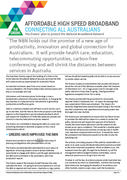BROADBAND REMAINS a key point of difference between Labor and the Coalition’s policies going into the election.
In summary the key differences in broadband policies are:
- The Coalition offers a lower-cost network that will provide customers with modest improvements in broadband services in the shorter term. But the Coalition’s network will create a new digital divide and require major upgrades soon after it is completed.
- Labor promises a more future-proof solution that will cost more at the outset, but will stimulate broadband developments in government, business, and entertainment, and which has potential to serve Australia until beyond 2050.
- The cost difference between these two alternatives is about $1,000 per premises.
The Greens do not explicitly address broadband in their Media and Communications policy documentation, apart from supporting affordable and equitable high-speed Internet access.
Table 1: Key aspects of the Labor and Coalition policies
|
|
|
|
|
Network Technologies |
|
|
|
Wired |
Fibre to the premises |
71% Fibre to the node and 22% fibre to the premises, primarily in greenfield sites |
|
Other |
Fixed wireless and satellite |
Fixed wireless and satellite |
|
Download Speed |
|
|
|
Wired |
1 Gbps |
50 Mbps in 90% of homes |
|
Wireless |
25 Mbps |
25 Mbps |
|
Satellite |
12 Mbps |
12 Mbps |
|
Upload Speed |
|
|
|
Wired |
400 Mbps |
10 Mbps |
|
Wireless |
5 Mbps |
5 Mbps |
|
Satellite |
1 Mbps |
1 Mbps |
|
Rollout completion date |
2021 |
2019 |
|
Total funding required |
$44.1 billion |
$29.5 billion |
|
Average funding |
$3,470 |
$2,450 |
|
Wholesale pricing |
Fixed |
Capped |
|
Monopoly |
NBNCo will remain the monopoly wholesale provider |
Competing broadband access networks will be permitted |
*Assuming 12.7 million premises
At the 2010 election, the Opposition leader Tony Abbott was threatening to scrap the National Broadband Network. However, under Malcolm Turnbull’s deft handling of the Shadow Communications Minister’s portfolio, the Coalition’s Broadband Policy now recognizes the need for a national, wholesale broadband network and shares many characteristics with the existing NBN model as conceived under Labor.
Like Labor’s NBN, an NBN under the Coalition will be a wholesale network, open to any retail service provider that can connect to the network. There are some differences in pricing strategies between the two policies, primarily around whether prices are uniform across the country – as in the Labor policy, or capped – as in the Coalition’s policy, but the service model is broadly the same.
Both Labor and the Coalition will use newly launched satellites to take broadband to remote areas, and fixed wireless to cover rural areas, where wired access such as fibre or copper is either technically unfeasible or economically unviable. But the key difference between the two policies is the network technology to be used in urban areas. Labor will continue rolling out a Fibre to the Premises (FTTP) network, while the Coalition policy calls for a shift to Fibre to the Node (FTTN) in brownfield sites (i.e. established urban areas), and FTTP in new housing estates (greenfield sites).
Despite some delays in the rollout of Labor’s FTTP network, NBNCo says the completion date for the project remains fixed at 2021, and that the total cost will be $44.1 billion.
Cost differences
The Coalition’s policy calls for completion of the rollout of their FTTN network by 2019, at a total cost of $29.5 billion. The difference in cost between Labor’s network and the Coalition’s network per premises is about $1,000. To put this in perspective, the recent rollout of smart electricity metres in Victoria cost about $1,200 per premises.
The central differences between the two policies boil down to differences in the cost of building the network, the download and upload speeds, and the usable lifetime of resulting infrastructure. The Coalition’s FTTN network will provide download speeds of 50 Mbps to 90% of connected homes, while Labor’s FTTP network will initially provide download speeds up to 1 Gbps - 20 times faster than the Coalition’s FTTN network. Labor’s FTTP network will provide upload speeds of 400 Mbps – 40 times faster than FTTN.
In essence, the Coalition’s FTTN network cost two-thirds as much as Labor’s FTTP network, based on the official cost estimates in each policy, but will be only one-twentieth as fast.
Speed differences
The speed difference between the two networks is that a FTTN relies on the existing copper connections between the node (a box in the street) and the premises, while in a FTTP network, the entire connection is by fibre. In recent years, engineers in laboratories around the world have developed technological marvels to extract the maximum capacity out of copper, and these marvels are to be incorporated in the Coalition’s network using VDSL technology.
But the download and upload speeds achievable with VDSL are a tiny fraction of the speeds achievable using FTTP. Furthermore, with VDSL in FTTN networks, the further the premises are located from the node, the slower the speed. In addition, the speed can be degraded if water gets into the cables after heavy rain, as some users notice in today’s ADSL network.
Table 2: Analysis of key issues not fully addressed in the available policy documents
|
|
|
|
|
Potential for Future Upgrade |
Upgrade to 10 Gbps will not require any civil works |
Upgrade to Fibre to the premises will require extensive civil works |
|
Cost of Future Upgrade |
$100 - $200 per premises (1 Gbps to 10 Gbps) |
$2000 - $5000 per premises (FTTN to FTTP) |
|
Potential to benefit the |
FTTP technology is ideally suited to providing backhaul to new transmitters that fill blackspots and increase network capacity. |
Coalition policy is to make NBNCo assets available for filling blackspots. But FTTN is less suited for this than FTTP. |
|
Date of obsolescence |
Beyond 2035, possibly beyond 2050 |
Around 2020. |
|
Power consumption |
Around 70 Megawatts |
Around 140 Megawatts |
Future demand for broadband
While few households need 1 Gbps today, the historical demand for broadband network bandwidth has grown at about 30% - 40% per annum. Today’s ADSL2+ network provides around 10 – 20 Mbps and many households find this to be barely sufficient, especially when two or three family members simultaneously access high-bandwidth applications, such as video on demand, gaming, or various kinds of home office applications.
Using historical growth figures, and allowing for future generations of ultra-high definition television, multi-view services, together with multiple TV displays in a single household, in-home video conferencing and so on, it is likely that domestic broadband domestic customers will be seeking bandwidths more than 100 Mbps by 2020 and about 1 Gbps by 2035. Extrapolated increases in download requirements could be supported until at least 2050, using a 10-Gbps upgrade to FTTP user modems.
Many business customers will require these bandwidths much sooner, as business users begin to take full advantage of new broadband applications and services, and to develop innovative new on-line products. Historically the development of applications tends to follow the provision of infrastructure. Applications that use increased speed tend to be developed only when those speeds are in existence or imminent.
Based on these numbers, the Coalition’s FTTN network will be obsolete by 2020, and will require major expensive upgrades after this. While it is possible that telecommunications engineers may find ways to squeeze a little bit more speed out of copper, the only way to move beyond the speed limitations of FTTN is to move the nodes closer to the home. In practice, this ultimately means an upgrade from FTTN to FTTP.
For those who need more than 50 Mbps from the FTTN network, the Coalition’s policy provides for a “fibre-on-demand” upgrade path, in which a customer pays for a fibre to be installed from the node in the street to the premises. The cost could be in the region of $1,000 - $5,000, depending on the distance of the node from the premises. Future upgrades of Labor’s FTTP to 10 Gbps and beyond will require simple exchange of the user terminal in the home, at a cost typically in the region of $100 - $200.
The Coalition’s “fibre-on-demand” strategy raises the spectre of a digital divide between households, businesses and regions that can afford to pay for the upgrade and those that cannot. For example, a graphic design business that uploads and downloads data to its customers, and that happens to be located close to a node, will be in a much better business position that a competitor 500 metres down the road. This will arguably impede the economic benefits of the network as a whole, limiting the application of health, education and productivity-boosting applications. This will mean that the saving of $1,000 per premises offered by the Coalition could easily be wiped out by the loss of long-term economic benefits of a high-capacity FTTP network.
The impact of mobile device
Some commentators have argued that the increasing popularity of mobile devices such as smart phones and tablets decreases the need for the NBN. But a FTTP broadband network will facilitate this rapid growth in mobile broadband. Telephone companies around the world are now enhancing their mobile networks with an ever-increasing number of small wireless base stations located on street corners, in shopping centres, offices, and even in customers’ homes, using fibre connections from the small base stations to their network. While NBNCo is not yet offering backhaul services to mobile operators, Labor’s FTTP network is ideally suited for this. Because the Coalition’s FTTN network relies on existing copper cable to the home, it is generally unsuitable for wireless backhaul.
Energy Consumption
Energy consumption is often overlooked in communications network planning, but is becoming increasingly important. The power consumption of the Labor’s FTTN network will be about 70 Megawatts and the Coalition’s FTTN network will consume twice that - about 140 Megawatts. The cost of this extra power is relatively small compared with the installation cost of the network, and this comparison does not include end-user devices such as computers and TV displays. But the increased electrical power consumption of the FTTN network will have a greenhouse impact approaching a city of the size of Launceston.
The Greens
(Update by Cathy Harper, Election Watch Editor, 15th August, 2013)
The Australian Greens support the building of Labor's Fibre to the Home National Broadband Network. The party believes the Fibre to the Home proposal is superior to the Opposition's proposal, which it says will entrench a two-‐tier telecommunications network.
The Greens also oppose the privatisation of the NBN because fast, widely available internet access will play an increasing role in healthcare, education and government services. The party wants the parliament and the public to retain a watchdog role.








